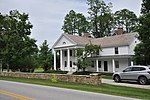Equinox Mountain
Mountains of Bennington County, VermontMountains of VermontNew England Hundred HighestTaconic MountainsWind farms in Vermont ... and 1 more
Wind power in Vermont

Equinox Mountain is the highest peak of the Taconic Range and the second-highest point in southern Vermont, after Stratton Mountain. It rises nearly 3,000 feet (914 meters) above its eastern footings in Manchester, giving Equinox the third-greatest topographic prominence among the state's mountains (after Mansfield and Killington). A summit observation building is reached via a privately operated toll road, which passes near various towers used for broadcast and other purposes.
Excerpt from the Wikipedia article Equinox Mountain (License: CC BY-SA 3.0, Authors, Images).Equinox Mountain
Skyline Drive,
Geographical coordinates (GPS) Address Nearby Places Show on map
Geographical coordinates (GPS)
| Latitude | Longitude |
|---|---|
| N 43.165988 ° | E -73.117574 ° |
Address
Skyline Drive
05254
Vermont, United States
Open on Google Maps







